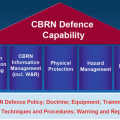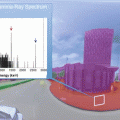Fig. 5.1
Basic framework for the PR&PP evaluation methodology
The challenges to the NESs are the threats posed by potential proliferant States and by sub-national adversaries. The technical and institutional characteristics of the NESs are used to evaluate the response of the system and determine its resistance to proliferation threats and robustness against sabotage and terrorism threats. The outcomes of the system response are expressed in terms of PR&PP measures and assessed.
The evaluation methodology assumes that an NES has been at least conceptualized or designed, including both the intrinsic and extrinsic protective features of the system. Intrinsic features include the physical and engineering aspects of the system; extrinsic features include institutional aspects, such as safeguards and external barriers. A major thrust of the PR&PP evaluation is to elucidate the interactions between the intrinsic and the extrinsic features, study their interplay, and then guide the path toward an optimized design.
The structure for the PR&PP evaluation can be applied to the entire fuel cycle or to specific elements of the chosen fuel cycle (reactor, front-end, or back-end of the particular fuel cycle under consideration). The methodology is organized as a progressive approach to allow evaluations to become more detailed and more representative as system design progresses. PR&PP evaluations should be performed at the earliest stages of design when flow diagrams are first developed in order to systematically integrate proliferation resistance and physical protection robustness into the designs of NESs along with the other possible high-level technology goals, such as safety and reliability, and economics. This approach provides early, useful feedback to designers, program policy makers, and external stakeholders from basic process selection (e.g., recycling process and type of fuel), to detailed layout of equipment and structures, to facility demonstration testing.
5.1.2 Some Safeguards and Security Considerations
The currently proposed GIF NESs may have new design features and technologies that could require new tools and measures for safeguards and security. Some international safeguards and national security considerations for advanced NESs may be different from those for existing nuclear systems.
International safeguards typically verify the operator’s declaration of activities with nuclear material. These declarations address the receipts, shipments, storage, movement, and production of nuclear material. Inspections depend on the material type and whether the material is irradiated. The IAEA state level approach [2] will in addition take into account the technical capabilities of the state including the possible existence of other nuclear activities (including commercial or academic R&D) and the location of the facilities.
The following considerations may pertain to physical security of an NES [3]:
Location and configuration of vital components so that gaining access to these components is extremely difficult and time consuming for an intruder
Location and configuration of critical safety systems so that there is not a capability to destroy multiple vital components from a single location
Incorporation of multiple layers of delay barriers against intruders and minimize the number of access points to areas containing vital assets
Consideration should also be given to physical security system designs options which minimize human involvement in security events, minimize impact of necessary future system modifications, and maximize adversary delay times.
5.2 Some Frequently Asked Questions (FAQ) About PR&PP
Recently, the PR&PP Working Group developed a list of frequently asked questions about the methodology and its applications. These questions and the corresponding answers are given here. They can also be found at: https://www.gen-4.org/gif/jcms/c_44998/faq-on-proliferation-resistance-and-physical-protection.
1.
What is the PR&PP evaluation approach?
The PR&PP methodology is a systematic and comprehensive tool for assessing and optimizing, at all stages of design, the level of proliferation resistance and physical protection of a nuclear energy system, or components thereof. It is a “pathways evaluation” approach which can account for a full range of hypothetical proliferation or terrorism scenarios (including diversion, misuse, clandestine operation, sabotage, and theft), and compute their impact against a set of high level measures.
2.
Why was the PR&PP methodology developed?
The PR&PP methodology was developed to address one of the four goals identified for future nuclear energy systems in the 2002 Generation IV Roadmap (i.e., next-generation power reactor designs that will see commercial deployment beyond 2030); “Generation IV nuclear energy systems will increase the assurance that they are a very unattractive (i.e., present significant barriers) and the least desirable route for diversion (i.e., removal by a State from a declared safeguarded facility, or used to produce undeclared nuclear material) or theft of weapons-usable materials, and provide increased physical protection against acts of terrorism.”
3.
What is the level of effort needed to perform a PR&PP evaluation?
The level of effort depends on the stage of design, the range of challenges evaluated, and the needs of the user performing the evaluation. The methodology is adaptable to differing needs. It can involve a single PR&PP expert with subject matter expert support from design staff (for a scoping study), or a team, requiring a few staff-months to a few staff-years.
4.
What is the time needed to perform a PR&PP evaluation?
The time requirement can be as little as a few weeks of work for a scoping study that evaluates the system response a small number of representative PR or PP challenges, to a year or more of work to evaluate response to a comprehensive spectrum of challenges.
5.
What is the form of the results?
The results take the form of tables of quantitative or qualitative measures indicating material being obtained, difficulty of obtaining the material and likelihood of detection. These results can be presented in various graphical or tabular forms, depending upon the needs of the individual user and the audience they will be presenting to.
6.




Who would use the results?
The range of users of the methodology includes designers, program policy makers, national regulators, international agencies, and other stakeholders.
Stay updated, free articles. Join our Telegram channel

Full access? Get Clinical Tree






